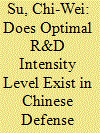|
|
|
Sort Order |
|
|
|
Items / Page
|
|
|
|
|
|
|
| Srl | Item |
| 1 |
ID:
177830


|
|
|
|
|
| Summary/Abstract |
This paper investigates whether there exists an optimal level of research and development (R&D) intensity, at which defense enterprises are able to maximize their market performance. The Panel Threshold Regression Model was applied to probe the link between R&D intensity and sales growth for defense listed enterprises, in China. The empirical results indicate that the Law of Gibrat does not hold and, unlimited input in R&D, does not guarantee positive paybacks. This may lead to the assumption that there is an optimal R&D intensity level in Chinese defense enterprises. Due to the fact that the defense industry has broken entrance barriers and considering the introduction of social capital into R&D activities, managers and top management should set more specific guidelines and provisional benchmarks to ensure effective R&D resource allocation in order to achieve maximum performance.
|
|
|
|
|
|
|
|
|
|
|
|
|
|
|
|
| 2 |
ID:
149185


|
|
|
|
|
| Summary/Abstract |
This article integrates various aspects of the office-seeking approach, the policy-seeking approach and the institutional rule approach to theories about establishing coalitions to create a new model that takes into account the mutual influence between the formation and stability of the coalition, party policies and the difference between the status of the party that formed the coalition and that of its coalition partners. It also introduces a new index based on mechanical physics to measure the degree of fragmentation in the coalition. Using data from the 20 terms of the Israeli Knesset, particularly the Twentieth Knesset, as our case study, the article demonstrates that large ideological distances between the political parties can be an advantage for the coalition’s formateur. The results confirm the validity of the proposed model, which awaits further validation in other parliaments worldwide.
|
|
|
|
|
|
|
|
|
|
|
|
|
|
|
|
| 3 |
ID:
106127


|
|
|
|
|
| Publication |
2011.
|
| Summary/Abstract |
The main objective of the paper is to decipher the military expenditure-economic growth relationship, taking the level of economic development (income) into consideration. Our findings suggest the following: (i) military expenditure has a significantly negative relationship to economic growth for the 23 countries with initial incomes (threshold variable) less than or equal to $475.93; (ii) when the threat level is heightened, economic growth (23 countries) is expected to decrease. However, military expenditure in the presence of sufficiently large threats increases growth; (iii) for the remaining 69 countries whose initial incomes (real GDP per capita in 1992 price) exceed $475.93, no significant relationship exists whether the threat variable is taken into consideration or not.
|
|
|
|
|
|
|
|
|
|
|
|
|
|
|
|
| 4 |
ID:
176705


|
|
|
|
|
| Summary/Abstract |
The existing literature on renewable energy consumption and economic growth nexus produces mixed results as the effect of renewable energy consumption on economic growth can be either positive, negative or not significant. This paper examines the causal link between renewable energy use and economic growth by employing a threshold model using a 103-country sample in the 1995 to 2015 period. We find that the relationship between renewable energy consumption and economic growth depends on the amount of renewable energy used. Our results demonstrate that the effect of renewable energy consumption on economic growth is positive and significant if and only if developing countries or non-OECD countries surpass a certain threshold of renewable energy consumption. However, if developing countries use renewable energy below a given threshold level, the effect of renewable energy consumption on economic growth is negative. However, we also find that renewable energy consumption has no significant effect on economic growth in developed countries and a positive and significant effect on economic growth in OECD countries. The findings of this paper suggest that for developing countries to realize positive economic growth from their investment to renewable energy, they need to surpass a certain threshold of renewable energy consumption.
|
|
|
|
|
|
|
|
|
|
|
|
|
|
|
|
| 5 |
ID:
166715


|
|
|
|
|
| Summary/Abstract |
Alleviating global climate change requires the development and adoption of green technology innovations. Particularly, the sustained economic growth requires green technology innovations in promoting carbon productivity, which is one of the central issues in raising standards of livings without detrimental consequences for global warming. However, the precise impacts of green technology innovations on carbon productivity are still unknown. Here we show that green technology innovations can only take effects for economies with high income, and it is difficult to find significant evidence that green technology innovations positively impact carbon productivity in less developed economies. The findings are quite robust using various alternative model specifications. Furthermore, our results demonstrate the importance of clarifying between development and adoption of green technology innovations. We propose that policy and public intention to raising living standard rather than environment, as well as lacking complementary supporting from other related innovations, represent barriers to adopt green technology innovations in less developed economies. In such countries, we anticipate our paper to attract attention to substantial upgrading of technologies by adopting green technology innovations in their new investments. The findings in this paper also highlight policies for encouraging worldwide green technology cooperation, such as accelerating green technology transfer across economies.
|
|
|
|
|
|
|
|
|
|
|
|
|
|
|
|
|
|
|
|
|